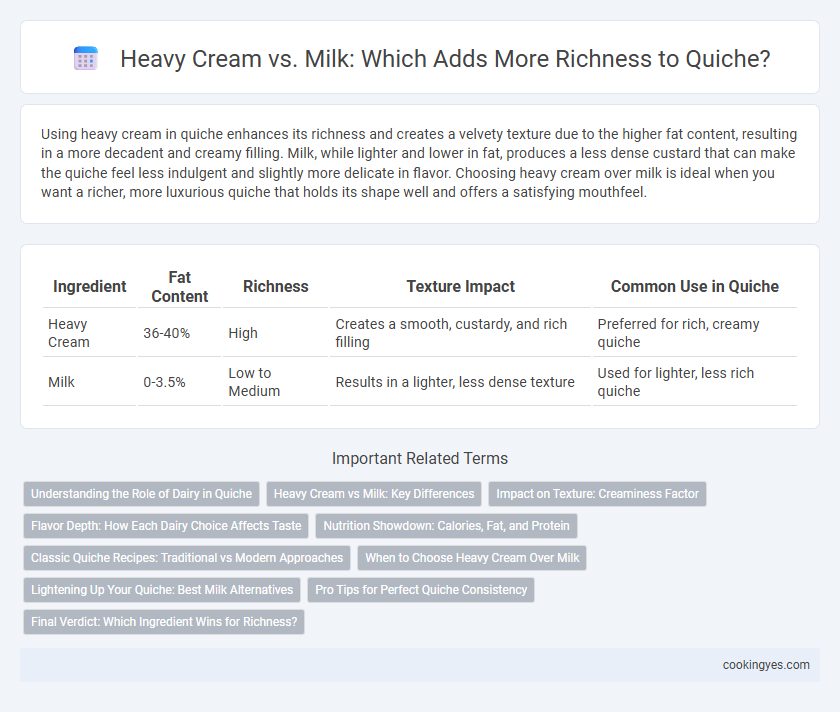Using heavy cream in quiche enhances its richness and creates a velvety texture due to the higher fat content, resulting in a more decadent and creamy filling. Milk, while lighter and lower in fat, produces a less dense custard that can make the quiche feel less indulgent and slightly more delicate in flavor. Choosing heavy cream over milk is ideal when you want a richer, more luxurious quiche that holds its shape well and offers a satisfying mouthfeel.
Table of Comparison
| Ingredient | Fat Content | Richness | Texture Impact | Common Use in Quiche |
|---|---|---|---|---|
| Heavy Cream | 36-40% | High | Creates a smooth, custardy, and rich filling | Preferred for rich, creamy quiche |
| Milk | 0-3.5% | Low to Medium | Results in a lighter, less dense texture | Used for lighter, less rich quiche |
Understanding the Role of Dairy in Quiche
Heavy cream enhances quiche richness by contributing higher fat content, resulting in a creamy, custard-like texture and more indulgent flavor. Milk provides a lighter, less dense filling with reduced fat, yielding a subtler taste and softer consistency. Understanding the role of dairy in quiche helps balance texture and flavor according to desired richness and dietary preferences.
Heavy Cream vs Milk: Key Differences
Heavy cream contains around 36-40% fat, offering a rich, velvety texture and deeper flavor to quiche, while milk typically has 3-4% fat, resulting in a lighter, less creamy custard. The high fat content in heavy cream enhances the smoothness and firmness of the quiche filling, creating a luxurious mouthfeel. Using milk produces a less dense quiche, which can be preferable for a lower-calorie option but sacrifices some of the traditional richness associated with classic quiches.
Impact on Texture: Creaminess Factor
Heavy cream significantly enhances quiche richness by increasing the creaminess factor, resulting in a silky, smooth texture due to its higher fat content of around 36-40%. In contrast, milk, with a lower fat percentage typically around 1-3.5%, produces a lighter, less dense custard that yields a firmer, less creamy quiche filling. The choice between heavy cream and milk directly influences the quiche's mouthfeel, with cream providing a luxuriously rich and velvety texture.
Flavor Depth: How Each Dairy Choice Affects Taste
Heavy cream enriches quiche with a velvety texture and deep, buttery flavor, intensifying its overall taste profile. Milk produces a lighter, more delicate custard, allowing other ingredients like herbs and cheese to shine without overwhelming richness. Opting for heavy cream enhances flavor depth, while milk offers a subtler, balanced quiche experience.
Nutrition Showdown: Calories, Fat, and Protein
Heavy cream significantly increases quiche richness through higher calories and fat content, typically containing around 400 calories and 43 grams of fat per cup. Milk offers a lighter alternative with approximately 150 calories and 8 grams of fat per cup, providing more protein (around 8 grams) compared to heavy cream's 3 grams. Choosing heavy cream creates a richer texture but also boosts caloric and fat intake, while milk yields a lower-calorie, higher-protein quiche option.
Classic Quiche Recipes: Traditional vs Modern Approaches
Classic quiche recipes often use heavy cream to achieve a rich, velvety texture, enhancing the custard's smoothness and depth of flavor. Modern approaches may substitute milk for heavy cream to reduce fat content, resulting in a lighter, less dense quiche without sacrificing the fundamental egg custard structure. The choice between heavy cream and milk significantly influences the quiche's mouthfeel and richness, with heavy cream providing a more indulgent experience favored in traditional preparations.
When to Choose Heavy Cream Over Milk
Heavy cream enhances quiche richness by adding a velvety texture and a higher fat content, ideal for recipes requiring a custard with a luxurious mouthfeel. Choose heavy cream over milk when aiming for a denser, creamier filling that holds its shape well during baking and delivers a decadent flavor. For lighter quiches, milk is suitable, but heavy cream is preferred to achieve a more indulgent and satisfying texture.
Lightening Up Your Quiche: Best Milk Alternatives
Using heavy cream in quiche enhances richness and provides a luxurious, velvety texture due to its high fat content, typically around 36-40%. For a lighter quiche, milk alternatives such as whole milk, 2%, or even unsweetened almond or oat milk reduce fat and calories while maintaining a creamy consistency. Incorporating these lighter options balances flavor and texture, creating a satisfying yet healthier quiche option without compromising moisture or custard-like quality.
Pro Tips for Perfect Quiche Consistency
Heavy cream enhances quiche richness by adding a velvety texture and higher fat content, resulting in a custard that is creamy and luxurious. Using milk produces a lighter, slightly firmer quiche with less density but can risk dryness if overbaked. For perfect quiche consistency, combine heavy cream with a bit of milk to balance richness and prevent the custard from becoming overly heavy or rubbery.
Final Verdict: Which Ingredient Wins for Richness?
Heavy cream delivers a significantly richer and creamier quiche due to its higher fat content, resulting in a luxurious texture and more indulgent flavor. Milk, with its lower fat percentage, produces a lighter and less dense custard, making it suitable for those seeking a milder taste and reduced richness. For maximum richness and a decadent quiche experience, heavy cream is the preferred ingredient.
Heavy cream vs milk for quiche richness Infographic

 cookingyes.com
cookingyes.com